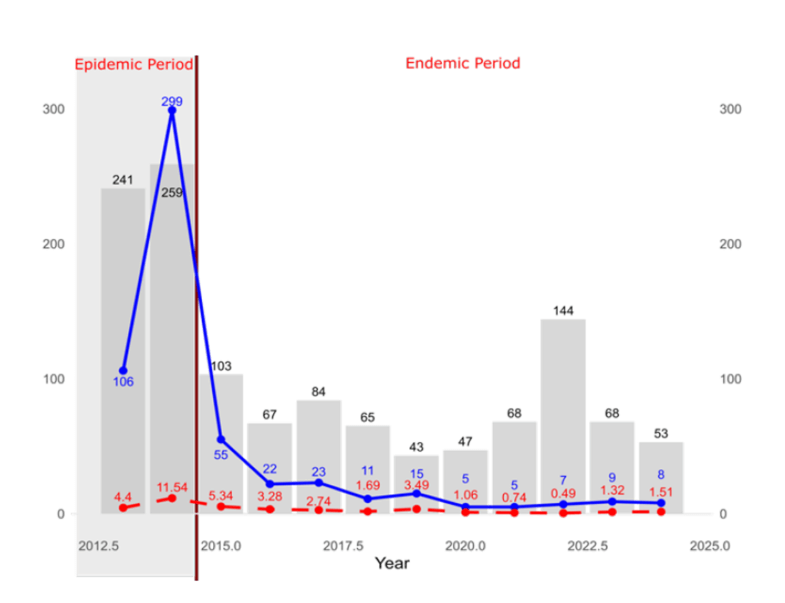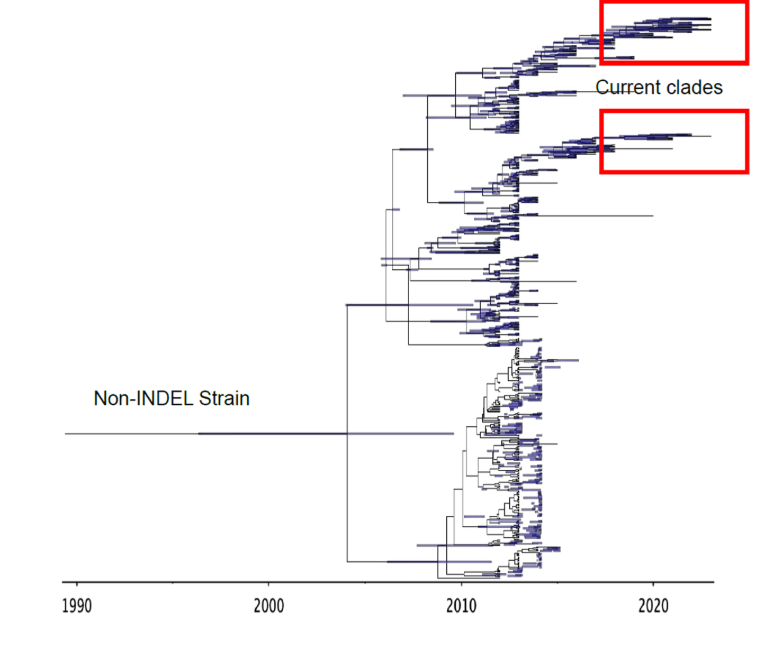
In April 2013, porcine epidemic diarrhea virus emerged in US pigs for the first time and since then has been an endemic pathogen causing significant production impacts to the swine industry. Team members including Drs. Joao Paulo Herrera da Silva, Nakarin Pamornchainavakul, and Kimberly VanderWaal partnerted with the SHIC-funded Morrison Swine Health Monitoring Project ream members Drs. Mariana Kikuti, Xiaomei Yue and Cesar Corzo of the University of Minnesota, to assess the long-term evolutionary dynamics of PEDV in US pigs a decade after its initial introduction to help guide practitioner strategies for future PEDV control.
PEDV causes acute enteric disease in nursing and post-weaning pigs with severe clinical signs in neonatal piglets, leading to significant economic losses. After the introduction of PEDV to the US in 2013, it spread rapidly and quickly emerged across 31 states. Two strains, indel and the more virulent non-indel, have been identified in the US to date. However, the current evolutionary status of PEDV in the US over the last 10 years remains largely unexplored. This MSHMP study provides an overview of PEDV evolution over the past decade.
Following PEDV introduction in the US, a high number of cases were reported through the MSHMP network during the first two years (gray bars in Figure 1), declining in the third year, and stabilizing thereafter with slight fluctuations. An exception was noted in 2021 when the incidence of PEDV was higher compared to all remaining years during the endemic period. Sequencing surveillance was also more intense during the epidemic phase (blue line in Figure 1), decreasing afterward with a consistent trend. During the endemic period, approximately one sequence was generated for every 10 infected sow farms in MSHMP (red line in Figure 1).
To assess the evolutionary dynamics of PEDV, the MSHMP team analyzed 556 spike protein sequences, focusing exclusively on the non-INDEL strain, which is predominant in the US. Although PEDV spike protein sequences exhibit high similarity (average nucleotide identity = 99.7%), a strong pattern of genetic differentiation was detected across time. Most sequences generated after 2017 clustered into two small sub-clades (red boxes, Figure 2). Circulation of these clades is restricted to specific geographic regions, suggesting compartmentalized circulation within those regions and limited spread between sow farms in different regions. This insight helps determine the risk of re-introduction of PEDV if it were regionally eliminated. No descendants derived from other clades present during the epidemic period were detected, suggesting that these clades are no longer circulating in the US (Figure 2).
Continued sequence surveillance is vital for the swine industry to advance toward disease eradication and is key to a) confirming the extinction of older clades, b) mapping the distribution of recent clades, and c) understanding PEDV’s evolutionary diversification. Taken together, this information can guide the strategies adopted by practitioners for PEDV control.
Find the MSHMP report here.


In April 2013, porcine epidemic diarrhea virus emerged in US pigs for the first time and since then has been an endemic pathogen causing significant production impacts to the swine industry. Team members including Drs. Joao Paulo Herrera da Silva, Nakarin Pamornchainavakul, and Kimberly VanderWaal partnerted with the SHIC-funded Morrison Swine Health Monitoring Project ream members Drs. Mariana Kikuti, Xiaomei Yue and Cesar Corzo of the University of Minnesota, to assess the long-term evolutionary dynamics of PEDV in US pigs a decade after its initial introduction to help guide practitioner strategies for future PEDV control.
PEDV causes acute enteric disease in nursing and post-weaning pigs with severe clinical signs in neonatal piglets, leading to significant economic losses. After the introduction of PEDV to the US in 2013, it spread rapidly and quickly emerged across 31 states. Two strains, indel and the more virulent non-indel, have been identified in the US to date. However, the current evolutionary status of PEDV in the US over the last 10 years remains largely unexplored. This MSHMP study provides an overview of PEDV evolution over the past decade.
Following PEDV introduction in the US, a high number of cases were reported through the MSHMP network during the first two years (gray bars in Figure 1), declining in the third year, and stabilizing thereafter with slight fluctuations. An exception was noted in 2021 when the incidence of PEDV was higher compared to all remaining years during the endemic period. Sequencing surveillance was also more intense during the epidemic phase (blue line in Figure 1), decreasing afterward with a consistent trend. During the endemic period, approximately one sequence was generated for every 10 infected sow farms in MSHMP (red line in Figure 1).
To assess the evolutionary dynamics of PEDV, the MSHMP team analyzed 556 spike protein sequences, focusing exclusively on the non-INDEL strain, which is predominant in the US. Although PEDV spike protein sequences exhibit high similarity (average nucleotide identity = 99.7%), a strong pattern of genetic differentiation was detected across time. Most sequences generated after 2017 clustered into two small sub-clades (red boxes, Figure 2). Circulation of these clades is restricted to specific geographic regions, suggesting compartmentalized circulation within those regions and limited spread between sow farms in different regions. This insight helps determine the risk of re-introduction of PEDV if it were regionally eliminated. No descendants derived from other clades present during the epidemic period were detected, suggesting that these clades are no longer circulating in the US (Figure 2).
Continued sequence surveillance is vital for the swine industry to advance toward disease eradication and is key to a) confirming the extinction of older clades, b) mapping the distribution of recent clades, and c) understanding PEDV’s evolutionary diversification. Taken together, this information can guide the strategies adopted by practitioners for PEDV control.
Find the MSHMP report here.